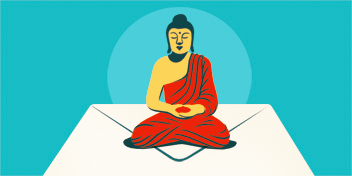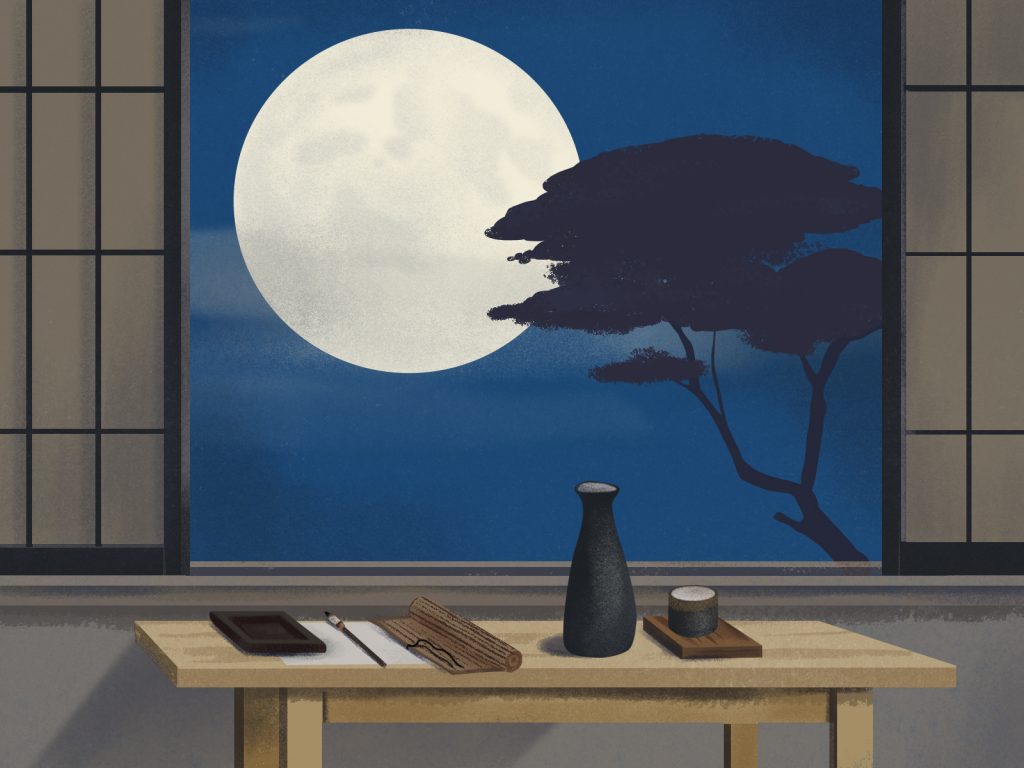Tricycle is offering free access to select articles during this uncertain time.
Your contribution helps make content like this possible.
Show your support for as little as $1.
As a season word honoring his memorial on November 28, “Basho’s ghost” invited our poets to reflect on the life of a man that most Japanese people simply think of as “the master.” Matsuo Basho was hardly the be-all, end-all of haiku. Nevertheless, from the beginning, he was the poet whose style and poetic philosophy most defined the art. The winning and honorable mention haiku for last month’s challenge focused on the somber, somewhat lonely mood that suffuses Basho’s mature poetry—a quality he felt was essential to the poetic spirit.
- Kelly Shaw experiences the contradiction at the heart of Basho’s poetry as “a lonesomeness yet / the desire to be alone.”
- Gregory Tullock wonders if the ghost of Basho might be “reading by moonlight” when the breeze turns a page of his book.
- David Bolton discovers the true secret of poetic solitude while “walking in the hermitage” of a crowded city street.
Congratulations to all! To read additional poems of merit from recent months, visit our Tricycle Haiku Challenge group on Facebook.
You can submit a haiku for the January challenge here.
Autumn Season Word: Basho’s ghost
WINNER:
a lonesomeness yet
the desire to be alone
the ghost of Basho
— Kelly Shaw
In 1680, the year he assumed leadership of the school of poetry founded by his teacher Soin, Matsuo Basho wrote a haiku that most scholars regard as the first verse in his mature style:
onto a bare branch
a crow has just settled down
this autumn evening
The poem is famous for its stark imagery, which stood in contrast to the style of Basho’s contemporaries, who were obsessed with wit and wordplay. “The poetry of other schools is like colored painting,” he wrote later. “The poetry of my school should be written as if it were black-ink painting.”
But if the image is somber, the mood is even more so. “The poet, tired of viewing spring flowers and autumn leaves, distilled the dusky loneliness of the fall season in the image of a crow,” wrote Tokai Donto (b. 1704), an early commentator on Basho’s poetry. “On a desolate autumn evening, his soul alighted on the crow.”
Basho chose a career that demanded constant interaction with other poets. And yet, he was drawn more and more to solitude with each passing year. Toward the end of his life, he would sometimes hang a “No Visitors” sign on the gate outside his hut—his lonesomeness and his desire for aloneness having made an uneasy truce. The winning poem for our November haiku challenge alludes to that period of his life.
The turn of thought is deceptively simple: One can miss others and still crave solitude, enjoy being alone and still long for a friend. But there is more to the poem than that.
Because their brevity leaves them open to multiple interpretations, haiku tend to be linguistically elusive. Is Basho’s crow poem about a bird, a bare branch, an autumn nightfall, or Basho himself? Or is the meaning of the poem to be found in the liminal, “dusky loneliness” of all four elements thrown together?
This month’s winner is notable for its complete absence of any image apart from “the ghost of Basho,” a spectral presence that may not even be visible. The turn of thought (more a turn of “feeling,” really) is set directly against that otherworldly image, leaving readers to make of the juxtaposition what they will.
On first reading, we are likely to feel that the poet has captured the emotional arc of Basho’s life—the mood swings that manifested alternatively as riotous verse-writing parties and journeys on foot to parts of Japan where he could wander for hours or days without seeing a single soul. But the word “ghost” can have so many meanings.
As a tribute to Basho, this was the best haiku of the month. But not because it captures his essential character. The subject of the poem is not Basho, ultimately, but the poet haunted by the spirit of his poetry more than three centuries after his death.
“A lonesomeness yet / the desire to be alone.” The words aren’t a description. They are a confession. The path of poetry is driven by contradictory impulses: to reflect in deep solitude and to share the fruits of that solitude with others. Basho is inside of him now.
HONORABLE MENTIONS:
a gust turns the page
or perhaps it’s Basho’s ghost
reading by moonlight
— Gregory Tullock
I meet Basho’s ghost
walking in the hermitage
of this midtown crowd.
— David Bolton
♦
You can find more on November’s season word, as well as relevant haiku tips, in last month’s challenge below:
Autumn season word: “Basho’s ghost”
always traveling
even dead he gets no rest
the ghost of Basho
Submit as many haiku as you wish that include the season word “Basho’s ghost.” Your poems must be written in three lines of 5, 7, and 5 syllables, respectively, and should focus on a single moment of time happening now.
Be straightforward in your description and try to limit your subject matter. Haiku are nearly always better when they don’t have too many ideas or images. So make your focus the season word* and try to stay close to that.
* REMEMBER: To qualify for the challenge, your haiku must be written in 5-7-5 syllables and include the words “Basho’s ghost.”
Haiku Tip: Celebrate The Spirit of Matsuo Basho!
Matsuo Basho, widely regarded as the greatest haiku poet, often lamented that he could never seem to settle down into a more conventional life. He might have married, but his preference for men made this unlikely. Had he become a priest, he might have secured a peaceful, relatively trouble-free existence. But such was not his path. Basho traveled the length and breadth of Japan to seek inspiration for his work, and he experimented with different styles of haiku up until the last year of his life. Geographically and poetically, Basho was always on the move.
When I first read Basho’s travel diaries as a teenager, I was troubled by his restlessness. He spoke candidly of his inability to stick with anything (except for haiku) or stay in any one place for long. Now I understand that this itself was a spiritual path—a “way” he followed until the end of his life. Consider his death poem:
Sick on a journey
my dreams go on wandering
through a withered field
His poetic mind was always seeking, always yearning toward some further expression of his art.
After decades of writing haiku, I have come to believe that what Basho called “a wind-swept spirit” is the essence of the art. Haiku is always dancing a little ahead of itself, a little out of reach. We arrive at the horizon only to realize there is another horizon. And when this life is done, the spirit wanders on.
A note on Basho’s ghost: Each year, Japanese haiku poets write hundreds of thousands of verses commemorating the death of Matsuo Basho on November 28, 1694. These poems nearly always include the season words Bashooki (“Basho Memorial Day”) or okina no ki (“Master’s Anniversary”). But neither of these strikes much of a cord outside of Japan. This month’s season word is an adaptation of that classical theme, recognizing late autumn as the season of Halloween, All Souls Day, and Day of the Dead—a time when the nights are longer and the veil between worlds is thinner, making it possible to commune with the spirits of the dead . . . including Basho.
Thank you for subscribing to Tricycle! As a nonprofit, we depend on readers like you to keep Buddhist teachings and practices widely available.

